

Sant'Agostino is a Renaissance style, former Roman Catholic church, located at the intersection of the Avenue Farnese and via Giordani in Piacenza, region of Emilia Romagna, Italy.


Sant'Agostino is a Renaissance style, former Roman Catholic church, located at the intersection of the Avenue Farnese and via Giordani in Piacenza, region of Emilia Romagna, Italy.
The adjacent convent was built during 1569-1573 by the Canons Regular of the Lateran, but the church building was not completed till 1608. The Lateransi had been in Piacenza since 1431, but had been evicted by the Pier Luigi Farnese from their prior holdings at the Monastery of San Marco. The neoclassical façade of the church was completed only in 1792 by Camillo Morigia. [1] The facade recalls the Roman triumphal arches, with statues and a pediment decorated with angels and garlands. At the end of the 18th-century, the monastery came to be used as a military hospital. [2] In 1798, the contents of this wealthy convent were auctioned to raise money to pay Napoleonic demands. This included a large library at the monastery. [3] In 1816, the monastery was converted into a school for young women. [4]
In 1828, the convent and church were bought by the city. After deconsecration and until the Second World War, the church and the monastery was used as barracks, hospital, and warehouse. [2] The interior of the church is decorated with frescoes by Trotti; Procaccini ; Nuvoloni; Bartolomeo Baderna; Gian Paolo Lomazzo (Refectory, 1567); Antonio Cifrondi; and Rubini . [5] The site is now deconsecrated and was used for exhibitions until 1985, and again since 2019. [6]
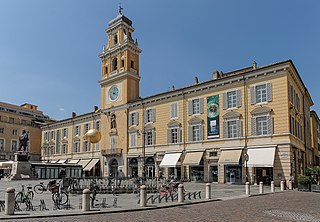
Parma is a city in the northern Italian region of Emilia-Romagna known for its architecture, music, art, prosciutto (ham), cheese and surrounding countryside. With a population of 198,292 inhabitants, Parma is the second most populous city in Emilia-Romagna after Bologna, the region's capital. The city is home to the University of Parma, one of the oldest universities in the world. Parma is divided into two parts by the stream of the same name. The district on the west side of the river is Oltretorrente. Parma's Etruscan name was adapted by Romans to describe the round shield called Parma.

Piacenza is a city and comune (municipality) in the Emilia-Romagna region of Northern Italy, and the capital of the eponymous province. As of 2022, Piacenza is the ninth largest city in the region by population, with more than 102,000 inhabitants.
Emilia is a historical region of northern Italy, which approximately corresponds to the western and the north-eastern portions of the modern region of Emilia-Romagna, with the area of Romagna forming the remainder of the modern region.
Sant'Eufemia is a Roman Catholic church located at the corner of the homonymous via and Via Boselli-Bonini in Piacenza, region of Emilia Romagna, Italy.
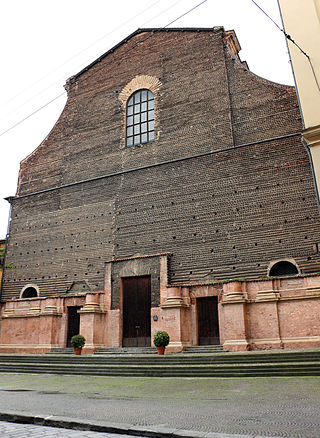
Santa Lucia is a large, deconsecrated Roman Catholic church, located on Via Castiglione #36 in central Bologna. The building's brick facade was never completed; however, the Jesuits, owners of the church for over two centuries, decorated the interior with Baroque chapels, aligned along a spacious nave. For over a century, after suppression of the church, the building had multiple secular uses, as a barracks, warehouse, training workshop, and even a gym. But since a restoration in 1986-1986, the building has been used as the main assembly hall for the University of Bologna.
The Church of Benedictines and its attached convent are a Baroque-style Roman Catholic church and monastery, located in central Piacenza, Emilia Romagna region, Italy.

San Francesco is a Roman Catholic church, located on Piazza Cavalli #68 in Piacenza, Italy. It was built in a style described as Lombard Gothic and is centrally located facing towards the Piazza del Cavalli, which is surrounded by the Palazzo Gotico and the Palazzo del Governatore.
San Pietro is a Roman Catholic church in central Piacenza, Emilia Romagna, Italy. The church was built over the site of an ancient church titled San Pietro in Foro.
San Sepolcro is a Renaissance style, Roman Catholic church and convent, located in Piacenza, Italy.
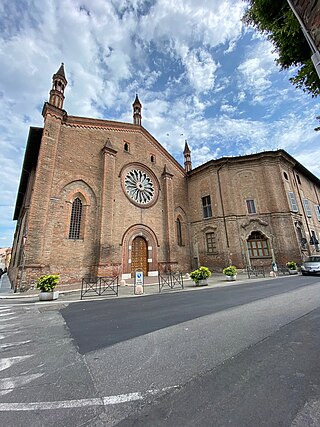
Sant'Anna is a Gothic style, Roman Catholic parish church, located at Via Scalabrini #83 in Piacenza, Region of Emilia Romagna, Italy.
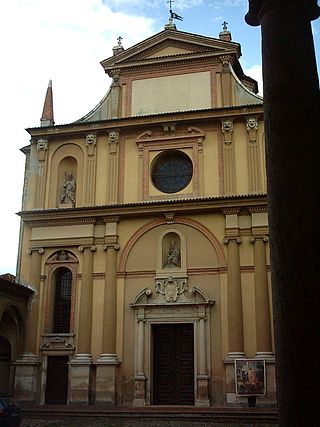
San Sisto is a Renaissance style, Roman Catholic church, located on the Via of the same name in north-central Piacenza, Region of Emilia Romagna, Italy.

San Paolo is a former convent in central Parma, Emilia-Romagna, northern Italy. It is best known for housing the Camera di San Paolo, decorated by a masterpiece of fresco work (1519) by Correggio.
The Chiesa dell'Osservanza or Santa Maria Annunziata dell'Osservanza is a Gothic-style, Roman Catholic church located in Viale Osservanza #198 in Cesena, region of Emilia-Romagna, Italy.

Santa Cristina is a Baroque-style, Roman Catholic church located on via Repubblica in Parma, region of Emilia-Romagna, Italy.
Santi Nazzaro e Celso, or Nazaro e Celso, is a deconsecrated Roman Catholic church located at the corner of Cantone San Nazzaro and via Taverna Giuseppe in Piacenza, region of Emilia Romagna, Italy. Since the 1980s, the space is occupied by the Galleria Rosso Tiziano, which sponsors exhibitions and cultural events.

San Vincenzo is a Baroque style, Roman Catholic church, now deconsecrated, located at Via Scalabrini #6 in the South-East quadrant of Piacenza, Region of Emilia Romagna, Italy. The church was restored starting in 2009 for use as an auditorium and to host concerts.
Santa Raimondo is a Baroque style, Roman Catholic church, attached to a functioning Benedictine order cloistered monastery occupied by San Raimondo nuns. It is located at Corso Vittorio Emanuele #154 in the southern edge of historic Piacenza, Region of Emilia Romagna, Italy.
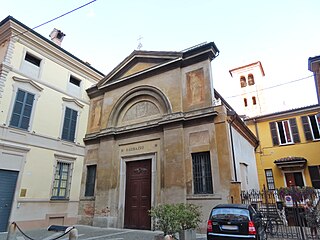
San Dalmazio is a Baroque style, Roman Catholic oratory or small chapel-church, located at via Mandelli #23, in front of the Palazzo Mandelli, in Piacenza, Region of Emilia Romagna, Italy.

The former Chiesa del Carmine is a Baroque style, now deconsecrated Roman Catholic church, located at Piazza Cassali #10, adjacent to the Casa del Mutilato in Piacenza, Region of Emilia Romagna, Italy. The space is now used for communal use administered by Laboratorio Aperto Piacenza.
Santa Margherita is a Baroque style, now deconsecrated Roman Catholic church, located at Vicolo Santa Margherita #9, in Piacenza, Region of Emilia Romagna, Italy. The church since 1992 is used as an auditorium for cultural events by the Fondazione di Piacenza e Vigevano.